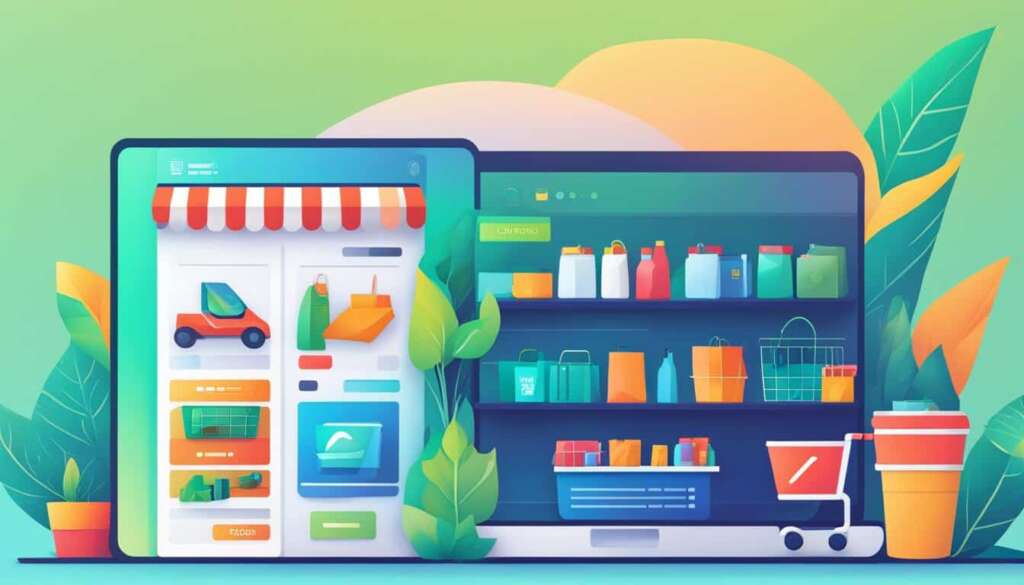Table of Contents
E-commerce, also known as electronic commerce, has transformed the way we shop and trade in the digital age. With the advent of the internet, individuals and businesses alike have embraced this convenient and efficient method of buying and selling products and services online.
Online shopping and trading have become an integral part of our lives, allowing us to browse and purchase a wide range of goods and services from the comfort of our own homes. Gone are the days of visiting physical stores or negotiating face-to-face; now, everything is just a few clicks away.
According to the U.S. Census Bureau, e-commerce sales have experienced significant growth, accounting for 9.7% of total sales in 2018 compared to just 1.6% in 2003. Experts predict that by 2022, e-commerce will comprise 17% of retail sales in the United States.
Technological advancements have been the driving force behind the evolution of e-commerce. The development of the electronic data interchange (EDI) and the introduction of secure online transactions through Secure Socket Layer (SSL) technology have paved the way for the seamless exchange of goods and services over the internet.
Major players in the e-commerce industry, such as Amazon and eBay, have played a pivotal role in shaping the e-commerce landscape, making online transactions the norm for millions of people worldwide. These platforms have revolutionized the way we conduct business and have created endless opportunities for entrepreneurs and consumers alike.
E-commerce encompasses various types of transactions, including business-to-consumer (B2C) and business-to-business (B2B) models. Businesses of all sizes can benefit from e-commerce, enjoying expanded reach, lower operating costs, and 24/7 accessibility for customers.
So, whether you’re a budding entrepreneur looking to start your own online business or a consumer seeking the convenience and variety of online shopping, understanding e-commerce is essential in today’s digital marketplace.
What is E-Commerce?
E-commerce, short for electronic commerce, is the term used to describe electronic transactions that take place on an online platform. It involves the buying and selling of products or services over the internet. Whether it’s purchasing and downloading digital music files, ordering physical goods for delivery, or reserving products online and picking them up in-person, all of these transactions fall under the umbrella of e-commerce.
There are various definitions of e-commerce, but according to the U.S. Census Bureau, it refers to the sales of goods and services where the buyer places an order or negotiates the price and terms of the sale through an online system. It’s important to note that payment may or may not be made online in all cases.
E-commerce encompasses both business-to-consumer (B2C) and business-to-business (B2B) transactions. In B2C e-commerce, businesses market their products directly to individual consumers, while B2B e-commerce involves businesses selling to other companies. The essence of e-commerce lies in the convenience and efficiency it offers, allowing people to engage in electronic transactions from the comfort of their own homes or offices.
The Comprehensive Definition of E-Commerce
“E-commerce refers to electronic transactions conducted on an online platform, involving the buying and selling of products or services. It encompasses both business-to-consumer (B2C) and business-to-business (B2B) transactions. The buyer places an order or negotiates the price and terms of the sale through an online system, and payment may or may not be made online.”
The comprehensive definition of e-commerce encompasses the broad scope of electronic transactions conducted online. It emphasizes the flexibility of e-commerce, allowing businesses and consumers to engage in a wide range of activities that involve the exchange of goods and services.
| E-commerce Types | Description |
|---|---|
| Business-to-Consumer (B2C) | Transactions involve businesses selling products or services directly to individual consumers. |
| Business-to-Business (B2B) | Transactions involve businesses selling products or services to other companies. |
As the table above illustrates, e-commerce can take different forms depending on the target audience and the nature of the transaction. By leveraging the power of technology and the internet, e-commerce has transformed the way we conduct trade and interact with businesses. It has opened up new avenues for entrepreneurs and provided consumers with greater convenience and access to a wider range of products and services.
The Evolution of E-Commerce
The evolution of e-commerce can be attributed to significant technological advancements that have shaped the way we conduct online transactions. In the 1960s, the introduction of the electronic data interchange (EDI) on primitive computer networks laid the foundation for e-commerce as we know it today. This system allowed for the seamless exchange of information between businesses electronically.
Another breakthrough in the evolution of e-commerce was the development of ARPAnet, a military network that enabled the electronic transfer of data. This innovation paved the way for the creation of the internet and the subsequent growth of online transactions.
In the 1980s, research computers at universities gained the ability to send emails and share documents, marking a significant milestone in digital communication. CompuServe’s Electronic Mall, introduced during this time, added online retail capabilities, making it one of the earliest examples of e-commerce.
In 1991, the ban on commercial businesses operating on the internet was lifted, leading to a surge in online transactions. Secure online transactions became possible in 1994 with the integration of Secure Socket Layer (SSL) technology, which ensured the privacy and security of sensitive information.
Two major players that revolutionized the e-commerce industry were Amazon and eBay. Launched in the mid-1990s, Amazon initially focused on selling books but later expanded to offer a wide range of products. eBay, on the other hand, started as an online auction platform that allowed individuals to buy and sell goods. Both companies played a pivotal role in shaping the e-commerce landscape and popularizing online transactions.
Today, technological advancements continue to drive the evolution of e-commerce, with innovations such as mobile commerce, artificial intelligence, and virtual reality shaping the industry. As technology continues to advance, e-commerce is becoming more accessible, convenient, and secure, further transforming the way businesses operate and consumers shop.

The Impact of Technological Advancements on E-Commerce
Technological advancements have played a vital role in the growth and development of e-commerce. Some of the key impacts include:
- Increased convenience and accessibility for consumers, allowing them to shop from anywhere and at any time.
- Streamlined supply chains and logistics through automated processes, resulting in faster delivery times.
- Data analytics and personalized marketing, enabling businesses to target consumers with relevant offers and recommendations.
- Enhanced security measures, minimizing the risk of fraudulent activities and protecting sensitive customer information.
The continuous evolution of technology will undoubtedly shape the future of e-commerce, presenting new opportunities and challenges for businesses. It is crucial for companies to stay abreast of these advancements and adapt their strategies to capitalize on the ever-changing digital landscape.
Types of E-Commerce
E-commerce encompasses various types of transactions, catering to different market segments and revenue models. Two primary categories of e-commerce are business-to-consumer (B2C) and business-to-business (B2B) e-commerce.
Business-to-Consumer (B2C) E-Commerce
In B2C e-commerce, businesses market products or services directly to individual consumers. This type of e-commerce has seen significant growth and popularity, with giants like Amazon and Walmart dominating the market. B2C e-commerce platforms provide a seamless online shopping experience, offering a wide range of products and services.
B2C e-commerce has transformed traditional retail, enabling customers to shop from the comfort of their homes and access a global marketplace. The convenience, variety, and competitive prices offered by B2C e-commerce platforms have made them the go-to destinations for millions of consumers worldwide.
Business-to-Business (B2B) E-Commerce
B2B e-commerce involves businesses selling products and services to other companies. This type of e-commerce caters to the needs of manufacturers, wholesalers, and service providers who supply goods or services to other businesses.
Examples include specialized web development services or office equipment suppliers. B2B e-commerce platforms streamline the procurement process, allowing businesses to connect, negotiate, and transact online. By embracing B2B e-commerce, companies can enhance efficiency, broaden their reach, and establish productive business relationships.
Market Segments and Revenue Models
Within the broader categories of B2C and B2B e-commerce, there are various market segments and revenue models. E-commerce businesses can tailor their offerings to niche markets or specialize in specific product categories, reaching a targeted audience.
Revenue models in e-commerce can be diverse, including traditional sales, subscription-based services, advertising, or freemium models. The flexibility afforded by e-commerce allows businesses of all sizes to adapt to different market dynamics and explore innovative revenue streams.
To provide further clarity, here is a comprehensive table summarizing the types of e-commerce, market segments, and revenue models:
| E-Commerce Type | Market Segments | Revenue Models |
|---|---|---|
| B2C E-Commerce | Retail, fashion, electronics, entertainment | Traditional sales, subscriptions, advertising |
| B2B E-Commerce | Manufacturing, wholesale, services | Contract-based sales, bulk orders |
| Niche Market E-Commerce | Specialized products or services | Premium pricing, exclusivity |
| Subscription-based E-Commerce | Membership services, software platforms | Recurring payments, tiered pricing |
| Freemium E-Commerce | Software as a Service (SaaS) | Basic features free, premium upgrades |
These market segments and revenue models highlight the diverse opportunities for e-commerce businesses to thrive in today’s digital landscape. By understanding the specific needs of their target audience and adopting the right revenue models, e-commerce entrepreneurs can optimize their online presence and achieve sustainable growth.
Conclusion
E-commerce has revolutionized the way people shop and conduct business. It has opened up doors of opportunity for individuals and companies to establish their own online businesses with ease. The advantages of e-commerce are plentiful, including global reach, lower operating costs, and the ability to serve customers 24/7. As a result, traditional brick-and-mortar stores have experienced significant transformation in the retail landscape.
However, it is important to note that traditional retail still holds its ground, and experts predict that future stores will adopt a showroom-like concept, focusing on innovation and meeting the evolving demands of consumers. Moving forward, aspiring entrepreneurs keen on venturing into the world of e-commerce need to conduct thorough research and plan meticulously. Choosing the right products, identifying the target market, and establishing a solid business model are crucial steps to success in this digital realm.
A well-designed website is an essential aspect of thriving in the online marketplace. It serves as a digital storefront for businesses, enticing and engaging customers. While e-commerce presents its fair share of challenges, it also brings immense opportunities for growth and profitability. By staying informed and adapting to the evolving landscape, entrepreneurs can create successful online businesses and tap into the vast potential of e-commerce.
FAQ
What is e-commerce?
E-commerce, short for electronic commerce, refers to the process of conducting transactions for tangible goods and services over the internet.
How can e-commerce be defined?
E-commerce refers to electronic transactions that take place online. If buying or selling of products or services is involved, it qualifies as e-commerce.
What are the major players in the e-commerce industry?
Major players in the e-commerce industry include Amazon and eBay, both of which have played a crucial role in shaping the online retail landscape.
What are the different types of e-commerce?
E-commerce encompasses various types, including business-to-consumer (B2C) and business-to-business (B2B) models.
How has e-commerce revolutionized the way people shop and conduct business?
E-commerce has provided opportunities for individuals and companies to start their own online businesses with low barriers to entry. It offers global reach, lower operating costs, and the ability to cater to a 24/7 customer base.













